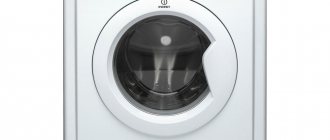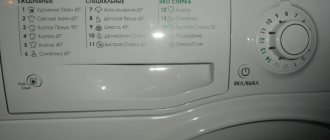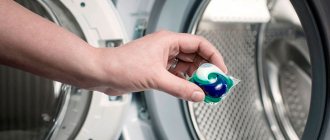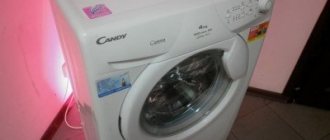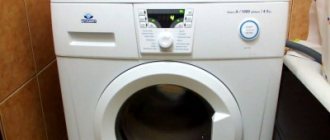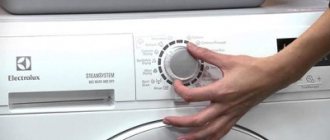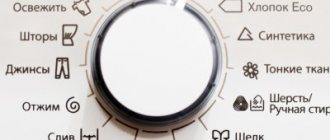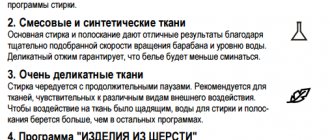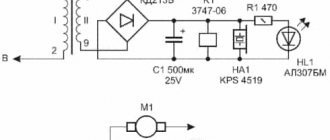A washing machine is an indispensable attribute of the life of a modern person. With this machine you can wash things in the shortest possible time. It saves time and money and allows you to select the required washing mode. Thanks to the washing machine, you will always have neat, good-smelling clothes.
However, not everyone knows how to properly operate the device. Many overload, do not clean, or even clog it. This leads to frequent breakdowns.
Let's look at the rules for using a washing machine to prevent defects from occurring.
Instructions before use
Each manufacturer has certain rules for using their products.
Many people do not read the instructions, preferring to study the device on their own, but this is a fatal mistake. Sometimes improper use of the device seriously shortens its service life.
Basic rules generalized for all companies:
- Do not overload the device by putting the recommended amount of items into the machine.
- Clean the product regularly, avoiding scale deposits.
- Carry out regular inspection and repair of broken parts.
- Do not exceed the service life of the product and do not neglect safety precautions.
The instructions are needed in order to:
- Find information that is not publicly available online.
- Learn to see the advantages and disadvantages of a product.
- Learn how to properly use a washing machine.
- Learn safety precautions when interacting with the device.
That is why do not neglect to study the instructions included with the product you just purchased. Sometimes reading the operating instructions will extend the functionality of a front- or top-loading machine for a long time.
Often, the instructions for use include such parameters as description, safety recommendations, equipment and what it includes, operating features, technical nuances, etc. You can also find the most common faults and how to fix them there.
Which mode to choose
As already mentioned, each machine has its own characteristics. Modes may vary depending on the manufacturer and year of manufacture.
However, there are several basic modes included in the functionality of any washing machine:
- Daily wash.
- Intensive wash.
- Preliminary.
- Manual.
- Night.
- Soaking (squeezing).
- Cotton and linen.
Daily wash
The main feature of washing is the half-empty drum.
Everyday washing is used for clothes that have not become very dirty. Reduces washing time. The water temperature is no more than 30 degrees Celsius. Duration - up to 50 minutes.
This mode can be used to wash work clothes of any color.
Prewash
It is chosen for very dirty clothes.
The washing process consists of slightly heating the water and a small number of revolutions.
The detergent (whether powder or capsules) is poured into two compartments. The first is used in the first cycle, the second - after draining the water.
Intensive wash
Used for things that are too dirty.
In this case, the water temperature reaches 95 degrees Celsius. Delicate fabrics should not be washed on this cycle.
Handwash
Used for thin materials. Look at the label: if you find an icon on it in the form of a hand in a basin, it means the item can be hand washed.
In this case, the drum rotates as slowly as possible, and the temperature does not exceed 40 degrees Celsius.
Night wash
The operation of the mode includes maximum quiet operation.
This option does not have a spin cycle, since it is the noisiest among the other functions of the machine. There is also no signal indicating the end of the wash.
Soak
This process prepares the clothes for washing.
The water temperature is no more than 30 degrees Celsius.
Cotton and linen
These materials require a special approach. There are several temperature criteria: 30, 40, 60 and 90 degrees.
It all depends on the quality of the item: the degree of contamination, the means used, etc. High temperatures help remove stubborn stains and grease, and low temperatures should be used to wash less dirty clothes.
What is the optimal washing temperature?
The right temperature for washing
Choosing the right temperature for washing depends on the fabric:
- Silk, wool and other delicate fabrics are washed at 30 degrees. Cold water takes better care of them and does not harm them.
- Bed linen and curtains can be washed at 30-40 degrees.
- Dirty children's clothes and towels can be placed at 40-60 degrees.
- They remove difficult stains and also disinfect linen and toys at a temperature of 95.
But before you choose the washing temperature manually, look at the label on the items; it has the optimal temperature at which the items will remain clean and not spoil.
Optional washing machine modes
Some manufacturers offer additional modes, which include rinsing, spinning, light ironing and intensive washing.
Let's consider each method in more detail.
Rinsing
In this mode, laundry is rinsed using conditioners (or without them, depending on the user’s needs).
Rinsing helps remove excess powder and also adds a pleasant scent and texture to clothes using conditioners and rinses.
In many models (even the old model!), rinsing is a built-in function and is used with every wash.
Easy ironing
This option allows you to wash clothes without subjecting them to strong mechanical stress. Using this mode, the laundry will not become wrinkled.
After washing, the product can be ironed at a low temperature or using dry ironing, as there are practically no wrinkles. Accordingly, steaming is not required.
Spin
This is a popular way to bypass the rinse step. Manufacturers have provided this function as a basic one in automatic washing machines.
There are several spin speeds (drum revolutions per minute):
- 400;
- 600;
- 800;
- 1000.
High spin speed keeps laundry as dry as possible. Items that are prone to wear out quickly (or simply delicate items) should not be spun.
Reference! When choosing a semi-automatic machine (Malyutka, Fairy), you should know that they do not always have a spin mode.
Intensive wash
A mode in which the washing machine spends much more water. As already mentioned, the mode is necessary for very dirty things.
Assumes the operation of the device for a long time (from 2 to 4 hours). In addition, during intensive washing there is a serious mechanical impact on your clothes at high temperatures.
Therefore, be careful when starting the program, as thin things may simply not withstand the load and become deformed.
What powders and other products should I use?
How can you wash things in a washing machine?
How clean yours will be depends not only on the washing machine, but also on the powders you use. Our recommendations:
- Choose powders that are machine washable and also look at the type of fabric (indicated on the packaging).
- Wash white items with bleach powder. This will help not only get rid of dirt, but also return things to their original white color.
- On the contrary, wash colored items without bleach so that they do not lose their brightness.
- Between dry and liquid products, choose liquid ones, because... they contain more active substances and are easily removed from things.
- If a stain remains after washing, try bleach (for whites) and stain remover (for colors).
- To keep things soft after using the washing machine, add not only the powder, but also the rinse aid.
Soaking and bleaching
The functions are presented in all modern models of washing machines. Even stubborn stains or grease can be removed by soaking.
The process goes like this:
- For 20 minutes, clothes are washed at a temperature of 30 degrees Celsius.
- After 20 minutes, the heating function turns off and things just spin every 40 seconds. Some models have variable time (from 20 to 50 seconds). Soaking improves the basic washing process and helps remove stains quickly.
Bleaching is recommended for light-colored items. For this, special powders and bleach are used.
Be sure to choose products based on the type of material you plan to wash. In most models, bleach is poured into the second compartment and the normal washing process begins.
You can set the wash to cotton or synthetic, depending on the fabric. All containers have a mark that allows you to control the amount of liquid in the compartment. This way you won't overdo it with the product.
Whitening should be done on a regular basis, but not too often. Remember that the use of overly aggressive products is fraught with deformation of the fabric and its rapid fading. Find a middle ground.
What to do before loading laundry
Before loading laundry, make sure the washing machine is working properly.
If you just purchased it, run a test wash. Look at the quality of work of the devices, inspect for any defects. If everything is fine, you can load your clothes.
Please note that there are several rules for sorting laundry.
Sorting
Clothes are always sorted by color, permitted washing temperature and other characteristics.
For example, delicate items (silk, linen, etc.) should not be washed on intensive cycles. However, cotton and durable fabrics like denim sometimes need a good wash.
Pay attention to the shades. Red clothes can be washed together with orange, pink and peach. Under no circumstances should cool shades be mixed with warm ones, otherwise the palette will be mixed. White laundry must be loaded separately, not mixed with other colors.
Also remember to empty your pockets before washing. Please note that any foreign objects entering the drum may cause internal defects in the appliance, resulting in poor functionality.
Take care of the condition of your machine so that it lasts for a long time.
Caring for your washing machine after washing
It is necessary not only to use such a device correctly, but also to follow some care recommendations. The main ones include the following:
- You need to carefully check your pockets before you start washing: small sharp objects can damage the entire device. Better yet, clean the drain filter once a month.
- You cannot stop the wash by “pulling it out” from the network - there is a special pause button for this. Otherwise it may break.
- There are various descaling agents, for example Calgon, which are added along with powders. Once a month you can add them yourself, without detergent (by the way, regular citric acid is also used for this). Just turn on the normal erase mode.
- After completing the process, you should not leave the bathroom: the assistant should be thanked for the work done with good care. Contaminants are removed, as well as remaining water in the drum.
More detailed answers to operating questions will be provided by the instructions supplied with the device. The main thing is to follow all the rules and proposed recommendations, then the device will meet all the requirements assigned to it.
Full drum or half
Sometimes it happens that the washing machine is not fully loaded. This is called "half load".
Some models have a special function for half-loading laundry. The function allows you not to accumulate a lot of dirty clothes, but to wash them gradually, running small cycles of small loads. Half wash saves a lot of water.
A full drum (up to 9 kg depending on the manufacturer) is recommended for those who are used to washing large volumes of fabrics. In this case, much more water is wasted, but washing occurs more intensively.
Is the washing machine working correctly?
Before starting the washing process, you need to make sure that the equipment is actually connected correctly.
- The water valve must be open, otherwise the washing simply will not take place. This circumstance implies that the machine is installed and pre-connected to both the sewer and water supply.
- It is important that the drain hose is installed correctly - otherwise a flood may occur.
- The machine operates from the mains. After completing the process, the plug from its cord must be unplugged from the socket.
- Next, all you have to do is press the power button: it will start lighting the entire control panel.
- All that remains is to pour powder specially designed for washing into the tray.
Using detergents
Many people believe that using washing powder is the perfect formula for quality washing. However, this is not true, because now there is a wide variety of analogues that cost several times less and work better.
The most popular laundry detergents: gels, capsules, powders and wipes.
Powder
One of the most versatile laundry detergents.
There are several main types of powders:
- Synthetic. They have an aggressive formula, and therefore are not always suitable for delicate products.
- Natural. Recently, a popular alternative to synthetic products. Produced with the addition of plant elements: oils, enzymes, extracts, etc. Unfortunately, due to the labor-intensive production, they are more expensive.
- Hypoallergenic. They do not contain irritating chemicals. Often used for washing children's clothes.
The most popular powder manufacturers:
- Ariel.
- Tide.
- Persil.
- SARMA.
Choose a tool based on your goals.
For example, for children's clothing you should choose powders that contain a minimum of aggressive substances. For dense fabrics, products with active chemical elements are suitable. However, do not overdo it, as in some cases the powder can cause fabrics to fade.
The cost of detergents in powder form remains low. Therefore, the powder is a budget option if you are looking for something inexpensive. Among the powders you can also find high-quality options of domestic and foreign production.
Gels
Now housewives are actively using powders in the form of gels.
The liquid composition has a concentrated structure, due to which the consumption of the substance becomes less.
The gel instantly dissolves in water and easily removes even old stains. There is an active effect on the fabric even in a cold solution. It is used to wash down jackets, jackets, blankets, etc.
In addition, the gel does not leave white streaks on any material.
The advantages also include ease of storage, the presence of airtight packaging and a measuring cup. Particularly active gels are used to remove fat.
Capsules
The product is versatile. Powder in the form of capsules or tablets combines several means that allow you to wash an item and condition it.
A capsule is a small container with one or more compartments. The most common capsules contain only gel.
The capsule shell dissolves immediately after entering the drum, as it is sensitive to water.
Capsules can be used in different modes, even with a quick wash. The gel inside quickly interacts with the tissue, performing its functions as quickly and efficiently as possible. Some capsules contain bleach, which is used for light-colored items.
The assortment is represented by manufacturers producing laundry detergents in the form of powders. The main disadvantage of the product remains its high cost.
Napkins
A relatively modern product, napkins prevent staining of clothes and allow you to wash laundry together, regardless of color.
The napkin is made of fabric containing surfactants. They are the ones who protect linen from shedding and sudden staining.
In addition, some manufacturers add bleach or powder to their products. That is, the napkin contains everything at once: a detergent, a conditioner, and protection against staining.
Accordingly, the price of this product is quite high. However, it is worth the investment.
Napkins can be purchased at stores that provide household goods.
How to start the program
1. Turn on the Indesit IWSB 5085 CIS washing machine by pressing the ON/OFF button. All indicators will light up for a few seconds, then go off, leaving the START/PAUSE indicator blinking. 2. Load laundry into the drum and close the hatch. 3. Use the PROGRAM knob to set the desired program. 4. Set the wash temperature (see “Personalized settings”). 5. Place detergents and additives (see “Detergents and types of laundry”). 6. Enable additional features you want. 7. Start the program using the START/PAUSE button, the corresponding indicator will turn green. To cancel a set cycle, switch the Indesit IWSB 5085 CIS machine to pause mode using the START/PAUSE button and select a new cycle. 8. When the program is completed, the indicator will light up. The sunroof can be opened after the HOOF LOCK indicator has turned off. Remove the laundry and leave the door half-open to dry the drum. Turn off the Indesit IWSB 5085 CIS washing machine by pressing the ON/OFF button.
Now we understand how to turn on the Indesit IWSB 5085 CIS washing machine, according to the algorithm written above.
How to turn on the timer?
Most manufacturers provide a timer on the washing machine.
The device is designed to count the washing time. It has a second step and begins functioning from the starting point of the machine on which it is installed.
There are several types of timers: hybrid and electronic. The first option is more reliable, while the second is multifunctional. However, the electronic version may break down, and therefore it is recommended to regularly inspect the device.
Setting the timer does not require specific knowledge.
To turn on the device, follow these steps:
- Turn on the machine by pressing the “power” button.
- We look for the timer symbol (dial), press.
- Choose the appropriate time.
- Let's start the timer.
Now you know how to use a washing machine. Keep an eye on its condition, and the device will serve you for a long period of time!
Full list of manufacturers:
- Aeg
- Ardo*
- Asko
- Beko
- Bosch
- Candy
- Daewoo
- Delfa
- Electrolux*
- Ergo
- Freggia
- Gorenje
- Hansa
- Hoover
- Hotpoint Ariston
- Ignis
- Indesit
- Kaiser
- Korting
- Midea
- Mirta
- Panasonic
- Samsung
- Saturn
- Siemens
- Smeg
- Tefal
- Vestel
- Whirlpool*
- Zanussi
- Atlant*
- error codes
- program tables
The instructions for the washing machine are available on the end pages with the models.


